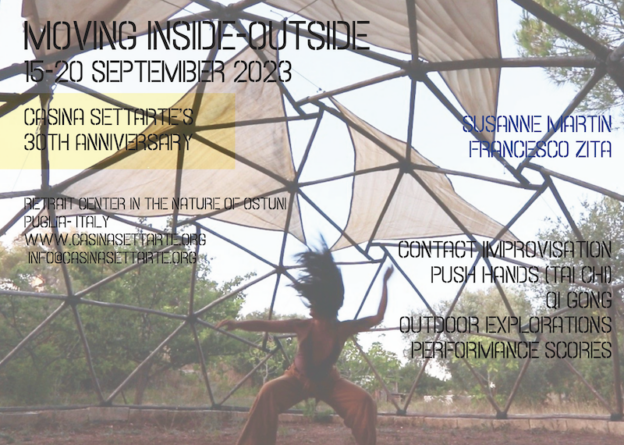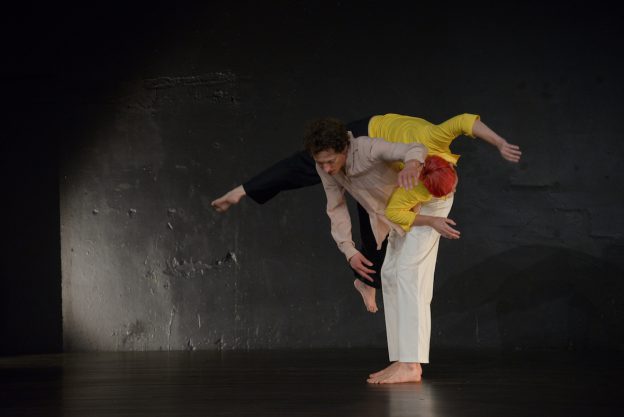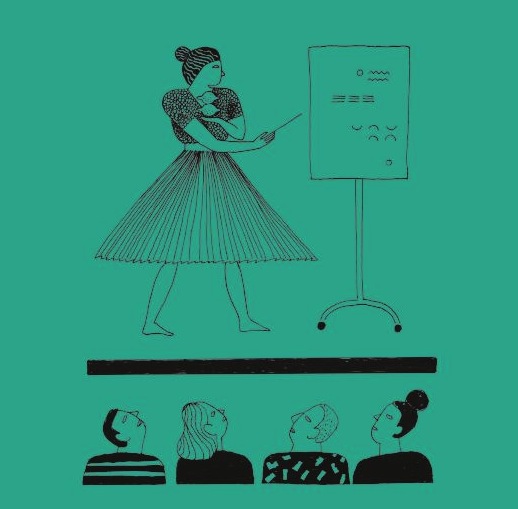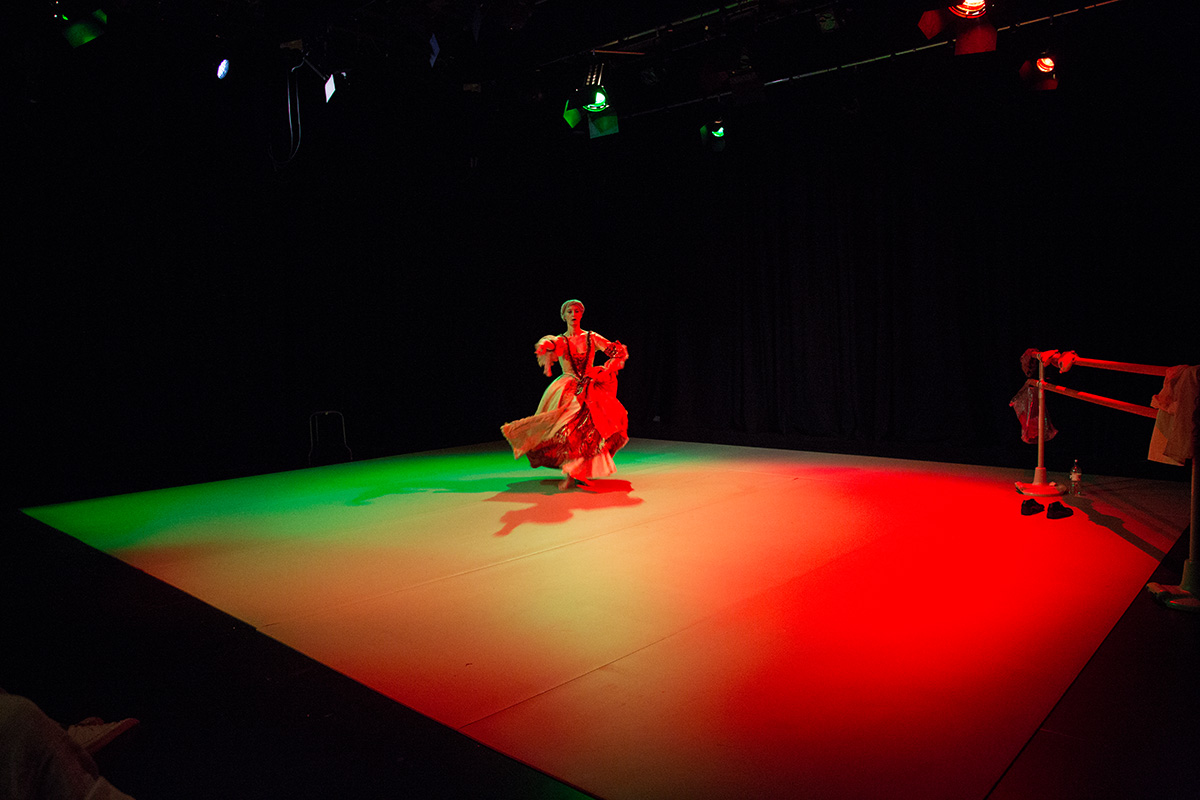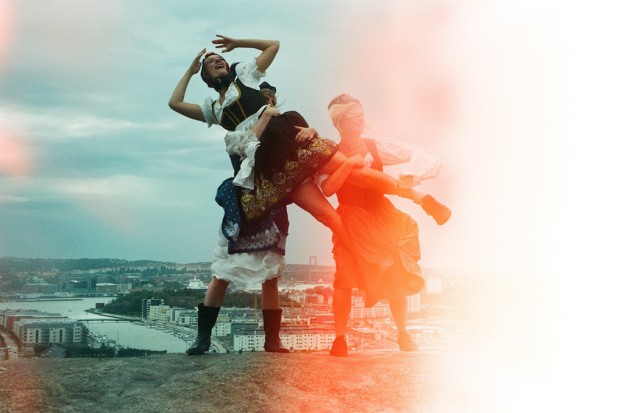24 May 2023 Jung bleiben und Sterben üben – eine Lecture Performance zu Alter(n) und Tanz, Ringvorlesung, Zentrum für interdisziplinäre Alterns- und Care-Forschung, Karl Franzen Universität Graz 4 December 2022 Üben, Üben, Üben NachWieVor – Fachtag Tanzperformance und Alter(n), Ehrenfeld Studios Köln, Germany 30 January 2020 Dancing Age(ing): an Ongoing Practice and a Danced Lecture… Continue reading Dancing Age(ing) lecture performances 2019 – 2023
Tag:Performance
Residential Workshop Italy 15 – 20 Sept 2023 Susanne & Francesco
MOVING INSIDE OUTSIDE Contact Improvisation – Push Hands (Tai Chi) – Qi Gong – Partnering – Outdoor Explorations – Performance Scores Intensive dance workshop with Susanne Martin and Francesco Zita at Casina Settarte, Puglia Italy, 15 – 20 September 2023 Susanne’s teaching is based in contact improvisation, instant composition and 30 years of creating performances… Continue reading Residential Workshop Italy 15 – 20 Sept 2023 Susanne & Francesco
Was ist Tanz? Seniorenakademie SKAT, April 2022
Centre Français BerlinMit Susanne Martin und Jan Burkhardt Durch eine Mischung von Vortrag, Workshop und Performance widmen wir uns einigen zentralen Tanzthemen wie zum Beispiel: Wonach gucken wir, wenn wir Tanz sehen?Woran denken wir, wenn wir selbst tanzen?Wie verhält sich Tanz zu Ton und zu Musik?Was könnte man wissen und was will ich wissen über… Continue reading Was ist Tanz? Seniorenakademie SKAT, April 2022
Performing Improvisation with L’Âme de Fonds 2021
Au beau milieu / Au bas mot, 29/30 Dec 2021, Neuchatel, Switzerland with Peter Aerni, Giacomo Calabrese, Simon Halbedo,, Chantal Langlotz, Simone Marty, Susanne Martin
Understanding Dance for Beginners and Intermediates, May 2020
This video tutorial (4 episodes) is a response to the statement “I don’t understand dance” – a sentence we encounter ever so often when moving away from the inner circles of dance lovers and dance experts. So, we attend to questions like: What do I look for when watching dance? What’s the relationship between dance,… Continue reading Understanding Dance for Beginners and Intermediates, May 2020
Performing Improvisation with L’Âme de Fonds 2017
28 – 30 December 2017 at L’Arsenic Lausanne, Switzerland with Giacomo Calabrese, Simon Henein, Chantal Langlotz, Lukas Langlotz, Susanne Martin, Alexandra Mcdonald, and morePhotos: Giacoma Calabrese, Simon Henein
teaching lately
– SS 2022 Erst- und Zweitbegegnungen mit Tanzimprovisation Evangelische Hochschule Berlin – SS 2022 Tanzimprovisation & Methoden künstlerischer Forschung Evangelische Hochschule Berlin- – 3.5.2022 Body and Voice in Teaching, Workshop EPFL Lausanne – 27.4.2022 Was ist Tanz? Workshop / Lecture Performance zusammen mit Jan Burkhardt, Centre Francais Berlin, https://centre-francais.de/events/skat-1-was-ist-tanz-mit-susanne-martin-und-jan-burkhardt/ – Somatic Research and Documentation Workshop… Continue reading teaching lately
About Susi & Gabi’s Salon
Susi & Gabi’s Salon Susanne Martin & Gabriele Reuter (Berlin) revive a European tradition that dates back to the 17th century; a salon is a gathering of people under the roof of an inspiring host (Susi & Gabi as Salonnières do their best to inspire!), held partly for amusement and partly to refine taste and… Continue reading About Susi & Gabi’s Salon
The Salon as Dance Mediation Format, a documentation of Salon #13 by Maren Witte
first published in Mapping Dance Berlin 2018 http://www.tanzraumberlin.de/files/map_broschure_web_fin_1.pdf Description of the setting and the idea of the formatThe latest edition of Susi & Gabi’s Salon marks the beginning of the Tanzfabrik showcase series “Open Spaces” from November 1-6, 2017. Two of the performance groups invited to the showcase can already present their work here and put… Continue reading The Salon as Dance Mediation Format, a documentation of Salon #13 by Maren Witte
Artistic Research Lecture Performances – other themes
– 3 April 2022 Miteinander improvisieren: Ein Tanz, ein Vortrag und zwei Übungen zum Sich-Anstecken, Lecture Performance, Symposium Gruppenpsychoanalyse, Wien – 25 October 2018 Ties & Bonds, together with Alex Nowitz, conference Alliances & Communalities, University of the Arts, Stockholm, Sweden – 7 April 2018 Learning. Teaching. Dancing. An interactive danced lecture, Tanzfabrik Berlin –… Continue reading Artistic Research Lecture Performances – other themes
Performing Improvisation at Bucharest Contact Improvisation Festival (2017)
22 June 2017, group improvisation performance of the teachers at Bucharest Contact Improvisation Festival, with Steven Batts, Inna Falkova, Elisa Ghion, Sergey Golovnya, Susanne Martin, Virginia Negru, Adrian Russi, Alexandra Soshnikova, venue: CNDB (Centrul Național al Dansului Bucuresti)
What do I teach (in 2019)?
My teaching deals mainly with dance, improvisation, performance, the body in different contexts, artistic research methods, or topics such as such as dance & age(ing) or improvisation & engineering, which developed out of my own artistic research. In which formats do I teach? – Workshops / Classes = practice oriented, limited time for verbal interaction… Continue reading What do I teach (in 2019)?
In Search for the Collective – Possibly a Solo – Probably an Improvisation (2016)
A recomposing of the opening scene of my solo The Fountain of Age (2014) -14 October 2016, Body IQ Festival, Somatische Akademie, Berlin -15 October 2016, Tatwerk Berlin
The Fountain of Age 2015
Photos W. Gillingham Sutton A Solo / Dance / Piece / Lecture / Performance / Research This solo performance constitutes one of two artistic outcomes I present as part of my PhD dissertation Dancing Age(ing) at Middlesex University London. Premiere: 18 June 2015, Ravensfield Theatre MIddlesex University LondonDuration: 40 minSupported by: Middlesex University London, Tanzfabrik… Continue reading The Fountain of Age 2015
Meeting Point Berlin, 24.11.13
The Meeting Point Berlin 2013 at Kunstquatier Bethanien is curated by Mireia Aragonés Carol. The performers of Meeting Point on 24. Nov.: Mireia Aragones, Rosella Canciello, Naima Ferre, Henrik Kaalund, Florian Knoblich, Susanne Martin, Sarah Simeoni, Barbara Topi,
Performing Improvisation 2013
Improvisation during summer workshop festival at Tanzfabrik Berlin, 24.7.2013 Simonetta Alessandri, Susanne Martin, Rick Nodine, Gabriele Reuter Photos: AnnA Stein
The Fountain of Youth & The Shadow 2013
Photos Lars Åsling, Graphic Sophie Jahnke The Shadow and The Fountain of Youth – Two Dances on Staying Alive As a new step in their long-term collaboration Bronja Novak Lindblad (Göteborg) & Susanne Martin (Berlin) have created each a solo on the same subject: the facts of getting older and sustaining in the world of… Continue reading The Fountain of Youth & The Shadow 2013
Hoppalappa Postfolki Tanzi Teateri 2008 – 2012
An improvisational performance project byKatarina Eriksson (San Francisco)Susanne Martin (Berlin)Bronja Novak Lindblad (Gothenburg)Coaching: Andrew MorrishProduction: Big WindSupported by: the city of Gothenburg and Statens Kulturråd The studio version:Sept. 2008, Konstepidemin Gothenburg The stage version:Premiered 23.5.2009, Atalante, GothenburgPerformance time: 75 minLight: Victor WendinTouring: Stockholm, Malmö, Berlin The site specific version:June 2012 in Gothenburg At the intersection… Continue reading Hoppalappa Postfolki Tanzi Teateri 2008 – 2012
Die Eigentümlichkeit, der Exhibitionismus und die Damen von Welt 2005
by Susanne Martin and Bronja Novak75 min. In English and Swedish language, also possible in German/English and English/English Premiere: 2005 at Atalante Gothenburg, SwedenSupported by: Statenskulturråd, Göteborgstads Kultur, Folkuniversitetet Performances: Gothenburg, Stockholm, Malmö, and in many many other Swedish cities, Berlin, Potsdam, Brunswick (USA), Chisinau (Moldova). To make a special evening an unforgettable one, Mesdames… Continue reading Die Eigentümlichkeit, der Exhibitionismus und die Damen von Welt 2005
